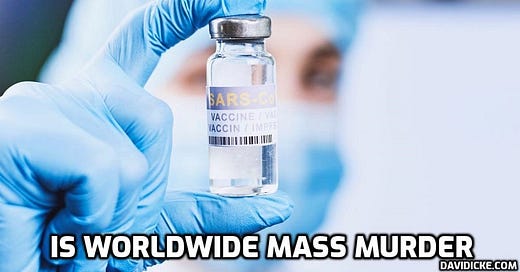Italian translation: https://www.thelivingspirits.net/morte-e-invalidita-non-solo-a-causa-della-proteina-spike-sono-state-trovate-altre-sostanze-tossiche-nei-sieri/
Many of my colleagues are doing their best to put out treatment protocols to help the Covid “vaccine” injured. There are two issues I have with most of the information that is being put out currently.
First of all, most are only focusing on the damage done by the Spike Protein. While this is very relevant, there are other toxic substances in the vials causing death and destruction. Twenty six research teams on five continents in 16 countries examined vials and blood of «vaccinated» people.1 They used various examination methods such as Optical Microscopy, Darkfield Microscopy, Phase Contrast Microscopy, Electronbeam Microscopy, UV Absorbance and Fluorescence Spectroscopy, Energy Dispersive Spectroscopy, X-Ray Diffractometry and Nuclear MRI.
The vials contain other substances besides mRNA and some don’t even contain mRNA. A researcher working with Steve Kirsch found PEG (Lipid Nano Particles) but no Phosphorus which would be found if there were mRNA in the vial. mRNA, RNA and DNA have a sugar-phosphate backbone. If there is no phosphate, there is no mRNA. Testing conducted by Dr. Kevin W. McCairn Ph.D. finds that both Pfizer & Moderna vaccines failed to register elemental signatures for Nitrogen and Phosphorous! Normal mRNA contains significant quantities of Nitrogen which forms Purines (A)denine, (G)uanine) & Pyrimadines (Uracil, Cytosine), which should be linked to a sugar-phosphate backbone.
Among the other toxic substances found in vials is Graphene Oxide. Graphene is considered to be the strongest material in the world, as well as one of the most conductive to electricity and heat. It’s an extremely aggressive free radical that depletes the body’s antioxidants Glutathione and SOD very rapidly, leaving the body defenseless against it. One of the experts in Graphene chemistry, Dr. Andreas Noack in Germany warned that it cuts cell membranes/ tissues, particularly blood vessels like razor blades.
Researchers2 in China studied the effects of Graphene in the body. Basically it can go everywhere, pass the Blood Brain barrier, Placental barrier, Lung and Testis barriers. Depending on the method of administration (oral, iv, sc, intratracheal, intraperitoneal), it can be found in lung, liver, spleen, bone marrow, blood vessels. It penetrates cell membranes, the nucleus and mitochchondria. Larger particles can get stuck in blood vessels. It breaks down cell membranes, breaks DNA strands, mutates DNA, fragments chromosomes and destroys proteins. It causes mitochondria to malfunction curbing cellular energy production. It causes aging and cancer. It causes massive inflammation and increases the inflammatory cytokines Interleukin 6, 12, TNFa and Nuclear Factor Kappa Beta. It activates immune cells and destroys them. It triggers cell necrosis and cell death leading to organ failure.
Next, researchers found toxic metals such as Aluminum, Antimony, Barium, Titanium and Cesium in the vials. They play havoc with enzyme systems and displace essential minerals. Aluminum is suspected to play a role in Alzheimer’s disease. By blocking an enzyme, ammonia increases in the blood causing impaired brain function with poor memory and confusion. It can also cause anemia and problems with the heart muscle. It is believed to trigger sarcoidosis, an auto-immune disease. Aluminum in the brain causes oxidative damage as it acts as a free radical. This is especially true when Iron is also present. Aluminum competes with and substitutes Magnesium and Calcium ions and it interferes with Calcium metabolism. Other toxic metals found are Antimony, Barium and Titanium. Cesium 137 is a radioactive toxic metal that was found in vials according to Todd Callendar and the German Working Group. Thulium was found in minute traces in some vials. Activated Thulium is used as a source of radiation for portable X-ray devices and in nuclear reactions. Despite being slightly expensive, superconductors of high-temperature use thulium. It is used for manufacturing ferrites and ceramic magnetic materials for microwave items.
Lastly and most importantly the vials contain Lipid Nano Particles/Hydrogels. These are used as a drug delivery system because they can pass through cell membranes and barriers such as the Blood Brain barrier and placental barrier. But they can do much more, which is why they are so dangerous. They can grow and fill out the cavity they are in, serve as a scaffolding or support structure on which cells can form tissues. They can react to external stimuli such as temperature, pH, light, electric and magnetic fields. They can be self-adapting, scalable and communicating sensor platforms capable of autonomous and/or cognitive action according to patent findings by Karen Kingston. Patents explain the abilities of LNPs such as creating, spawning, comprising, modifying, repairing, regenerating, reassembling and or control and regulation of one or more cells, cellular elements, cell organelles, including actions and behaviors involving cellular processes.
Dr. David Nixon, Dr. Ana-Maria Mihalcea, Shimon Yanowitz and others have been observing these LNP, also called Hydrogels, assembling structures that look like microchips. They grow to unbelievable sizes, obstructing blood vessels. It is very likely that they form the rubbery clots that funeral directors and morticians are pulling out of the blood vessels of the deceased.
The second issue I have with treatment protocols put out there for spike protein is the heavy use of allopathic medicine such as Ivermectin, Hydroxychloroquin, Budesonid and Fluvoxamin. In acute situations they are appropriate for the short term. For long term repair of the damage though, there exist natural treatment options, which I will write about in my next Substack post.
CITATIONS
1. What is in the so-called COVID-19 «Vaccines»? Part 1: Evidence of a Global Crime Against Humanity. International Journal of Vaccine. Theory, Practice, and Research 2(2), September 3, 2022 Page 586
2. . Toxicity of graphene-family nanoparticles: a general review of the origins and mechanisms. Particle and Fibre Toxicology (216) 13:57 DOI 10.1186/s12989-016-0168-y Lingling Ou et al.




